BSBHRM507 Assessment 1 - Answer Sheet
VerifiedAdded on 2023/06/07
|12
|3355
|405
AI Summary
This answer sheet covers questions related to managing separations and terminations in organisations. It includes information on best practice policies, industrial relations legislation, disciplinary procedures, dismissal, suspension, resignation, redundancy, and retirement.
Contribute Materials
Your contribution can guide someone’s learning journey. Share your
documents today.
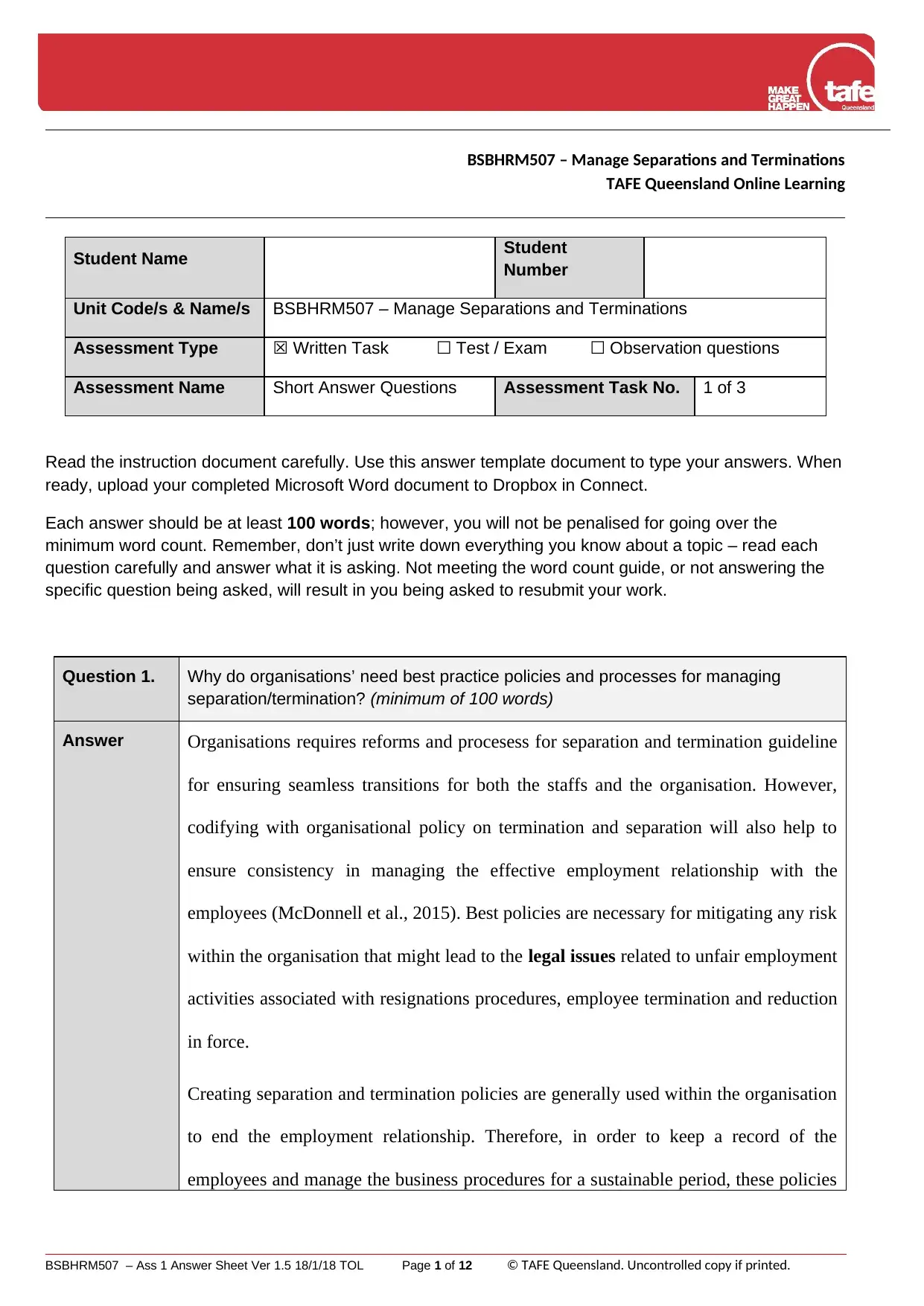
BSBHRM507 Assessment 1 – Answer Sheet
BSBHRM507 – Manage Separations and Terminations
TAFE Queensland Online Learning
Student Name Student
Number
Unit Code/s & Name/s BSBHRM507 – Manage Separations and Terminations
Assessment Type ☒ Written Task ☐ Test / Exam ☐ Observation questions
Assessment Name Short Answer Questions Assessment Task No. 1 of 3
Read the instruction document carefully. Use this answer template document to type your answers. When
ready, upload your completed Microsoft Word document to Dropbox in Connect.
Each answer should be at least 100 words; however, you will not be penalised for going over the
minimum word count. Remember, don’t just write down everything you know about a topic – read each
question carefully and answer what it is asking. Not meeting the word count guide, or not answering the
specific question being asked, will result in you being asked to resubmit your work.
Question 1. Why do organisations’ need best practice policies and processes for managing
separation/termination? (minimum of 100 words)
Answer Organisations requires reforms and procesess for separation and termination guideline
for ensuring seamless transitions for both the staffs and the organisation. However,
codifying with organisational policy on termination and separation will also help to
ensure consistency in managing the effective employment relationship with the
employees (McDonnell et al., 2015). Best policies are necessary for mitigating any risk
within the organisation that might lead to the legal issues related to unfair employment
activities associated with resignations procedures, employee termination and reduction
in force.
Creating separation and termination policies are generally used within the organisation
to end the employment relationship. Therefore, in order to keep a record of the
employees and manage the business procedures for a sustainable period, these policies
BSBHRM507 – Ass 1 Answer Sheet Ver 1.5 18/1/18 TOL Page 1 of 12 © TAFE Queensland. Uncontrolled copy if printed.
BSBHRM507 – Manage Separations and Terminations
TAFE Queensland Online Learning
Student Name Student
Number
Unit Code/s & Name/s BSBHRM507 – Manage Separations and Terminations
Assessment Type ☒ Written Task ☐ Test / Exam ☐ Observation questions
Assessment Name Short Answer Questions Assessment Task No. 1 of 3
Read the instruction document carefully. Use this answer template document to type your answers. When
ready, upload your completed Microsoft Word document to Dropbox in Connect.
Each answer should be at least 100 words; however, you will not be penalised for going over the
minimum word count. Remember, don’t just write down everything you know about a topic – read each
question carefully and answer what it is asking. Not meeting the word count guide, or not answering the
specific question being asked, will result in you being asked to resubmit your work.
Question 1. Why do organisations’ need best practice policies and processes for managing
separation/termination? (minimum of 100 words)
Answer Organisations requires reforms and procesess for separation and termination guideline
for ensuring seamless transitions for both the staffs and the organisation. However,
codifying with organisational policy on termination and separation will also help to
ensure consistency in managing the effective employment relationship with the
employees (McDonnell et al., 2015). Best policies are necessary for mitigating any risk
within the organisation that might lead to the legal issues related to unfair employment
activities associated with resignations procedures, employee termination and reduction
in force.
Creating separation and termination policies are generally used within the organisation
to end the employment relationship. Therefore, in order to keep a record of the
employees and manage the business procedures for a sustainable period, these policies
BSBHRM507 – Ass 1 Answer Sheet Ver 1.5 18/1/18 TOL Page 1 of 12 © TAFE Queensland. Uncontrolled copy if printed.
Secure Best Marks with AI Grader
Need help grading? Try our AI Grader for instant feedback on your assignments.
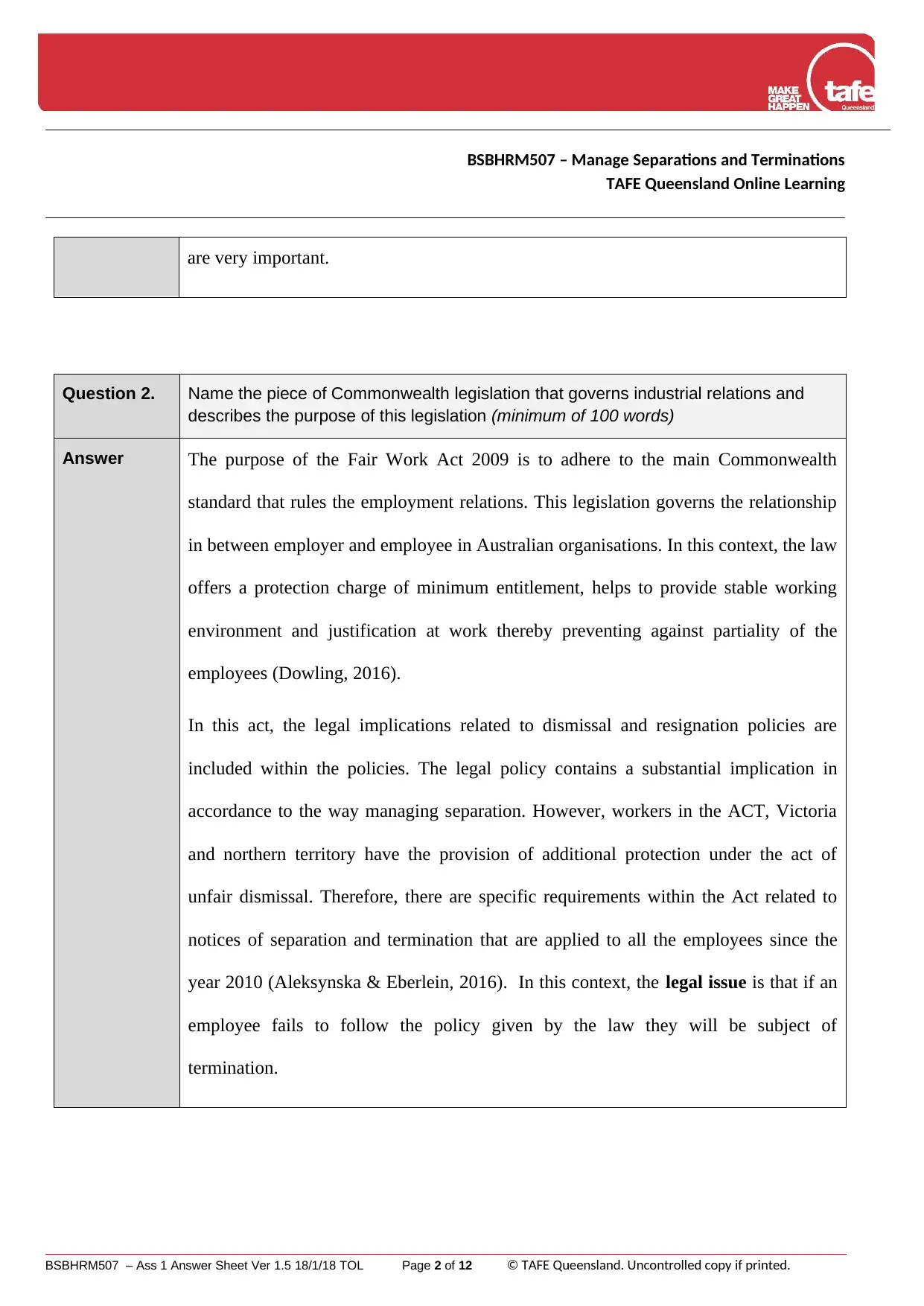
BSBHRM507 Assessment 1 – Answer Sheet
BSBHRM507 – Manage Separations and Terminations
TAFE Queensland Online Learning
are very important.
Question 2. Name the piece of Commonwealth legislation that governs industrial relations and
describes the purpose of this legislation (minimum of 100 words)
Answer The purpose of the Fair Work Act 2009 is to adhere to the main Commonwealth
standard that rules the employment relations. This legislation governs the relationship
in between employer and employee in Australian organisations. In this context, the law
offers a protection charge of minimum entitlement, helps to provide stable working
environment and justification at work thereby preventing against partiality of the
employees (Dowling, 2016).
In this act, the legal implications related to dismissal and resignation policies are
included within the policies. The legal policy contains a substantial implication in
accordance to the way managing separation. However, workers in the ACT, Victoria
and northern territory have the provision of additional protection under the act of
unfair dismissal. Therefore, there are specific requirements within the Act related to
notices of separation and termination that are applied to all the employees since the
year 2010 (Aleksynska & Eberlein, 2016). In this context, the legal issue is that if an
employee fails to follow the policy given by the law they will be subject of
termination.
BSBHRM507 – Ass 1 Answer Sheet Ver 1.5 18/1/18 TOL Page 2 of 12 © TAFE Queensland. Uncontrolled copy if printed.
BSBHRM507 – Manage Separations and Terminations
TAFE Queensland Online Learning
are very important.
Question 2. Name the piece of Commonwealth legislation that governs industrial relations and
describes the purpose of this legislation (minimum of 100 words)
Answer The purpose of the Fair Work Act 2009 is to adhere to the main Commonwealth
standard that rules the employment relations. This legislation governs the relationship
in between employer and employee in Australian organisations. In this context, the law
offers a protection charge of minimum entitlement, helps to provide stable working
environment and justification at work thereby preventing against partiality of the
employees (Dowling, 2016).
In this act, the legal implications related to dismissal and resignation policies are
included within the policies. The legal policy contains a substantial implication in
accordance to the way managing separation. However, workers in the ACT, Victoria
and northern territory have the provision of additional protection under the act of
unfair dismissal. Therefore, there are specific requirements within the Act related to
notices of separation and termination that are applied to all the employees since the
year 2010 (Aleksynska & Eberlein, 2016). In this context, the legal issue is that if an
employee fails to follow the policy given by the law they will be subject of
termination.
BSBHRM507 – Ass 1 Answer Sheet Ver 1.5 18/1/18 TOL Page 2 of 12 © TAFE Queensland. Uncontrolled copy if printed.
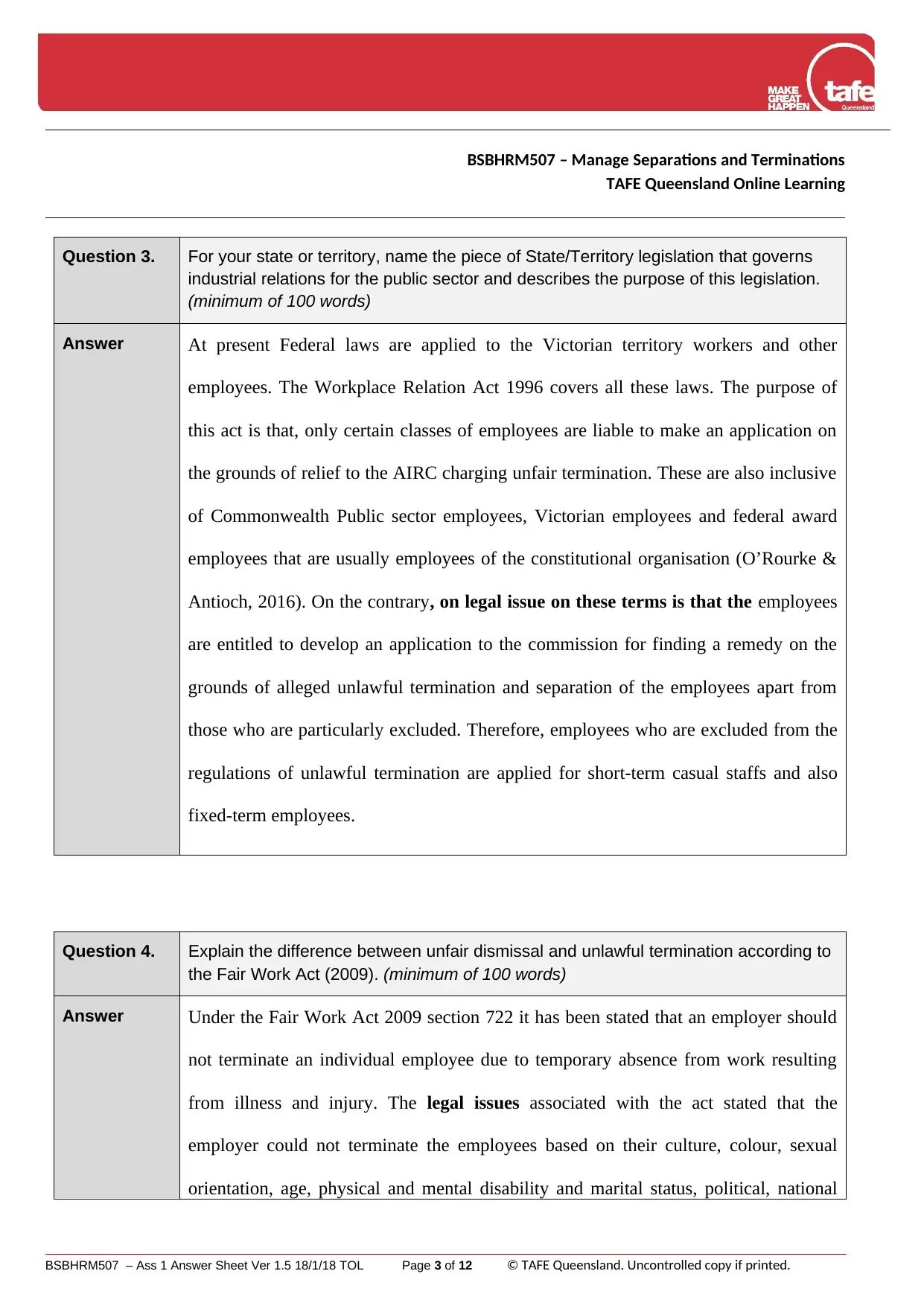
BSBHRM507 Assessment 1 – Answer Sheet
BSBHRM507 – Manage Separations and Terminations
TAFE Queensland Online Learning
Question 3. For your state or territory, name the piece of State/Territory legislation that governs
industrial relations for the public sector and describes the purpose of this legislation.
(minimum of 100 words)
Answer At present Federal laws are applied to the Victorian territory workers and other
employees. The Workplace Relation Act 1996 covers all these laws. The purpose of
this act is that, only certain classes of employees are liable to make an application on
the grounds of relief to the AIRC charging unfair termination. These are also inclusive
of Commonwealth Public sector employees, Victorian employees and federal award
employees that are usually employees of the constitutional organisation (O’Rourke &
Antioch, 2016). On the contrary, on legal issue on these terms is that the employees
are entitled to develop an application to the commission for finding a remedy on the
grounds of alleged unlawful termination and separation of the employees apart from
those who are particularly excluded. Therefore, employees who are excluded from the
regulations of unlawful termination are applied for short-term casual staffs and also
fixed-term employees.
Question 4. Explain the difference between unfair dismissal and unlawful termination according to
the Fair Work Act (2009). (minimum of 100 words)
Answer Under the Fair Work Act 2009 section 722 it has been stated that an employer should
not terminate an individual employee due to temporary absence from work resulting
from illness and injury. The legal issues associated with the act stated that the
employer could not terminate the employees based on their culture, colour, sexual
orientation, age, physical and mental disability and marital status, political, national
BSBHRM507 – Ass 1 Answer Sheet Ver 1.5 18/1/18 TOL Page 3 of 12 © TAFE Queensland. Uncontrolled copy if printed.
BSBHRM507 – Manage Separations and Terminations
TAFE Queensland Online Learning
Question 3. For your state or territory, name the piece of State/Territory legislation that governs
industrial relations for the public sector and describes the purpose of this legislation.
(minimum of 100 words)
Answer At present Federal laws are applied to the Victorian territory workers and other
employees. The Workplace Relation Act 1996 covers all these laws. The purpose of
this act is that, only certain classes of employees are liable to make an application on
the grounds of relief to the AIRC charging unfair termination. These are also inclusive
of Commonwealth Public sector employees, Victorian employees and federal award
employees that are usually employees of the constitutional organisation (O’Rourke &
Antioch, 2016). On the contrary, on legal issue on these terms is that the employees
are entitled to develop an application to the commission for finding a remedy on the
grounds of alleged unlawful termination and separation of the employees apart from
those who are particularly excluded. Therefore, employees who are excluded from the
regulations of unlawful termination are applied for short-term casual staffs and also
fixed-term employees.
Question 4. Explain the difference between unfair dismissal and unlawful termination according to
the Fair Work Act (2009). (minimum of 100 words)
Answer Under the Fair Work Act 2009 section 722 it has been stated that an employer should
not terminate an individual employee due to temporary absence from work resulting
from illness and injury. The legal issues associated with the act stated that the
employer could not terminate the employees based on their culture, colour, sexual
orientation, age, physical and mental disability and marital status, political, national
BSBHRM507 – Ass 1 Answer Sheet Ver 1.5 18/1/18 TOL Page 3 of 12 © TAFE Queensland. Uncontrolled copy if printed.
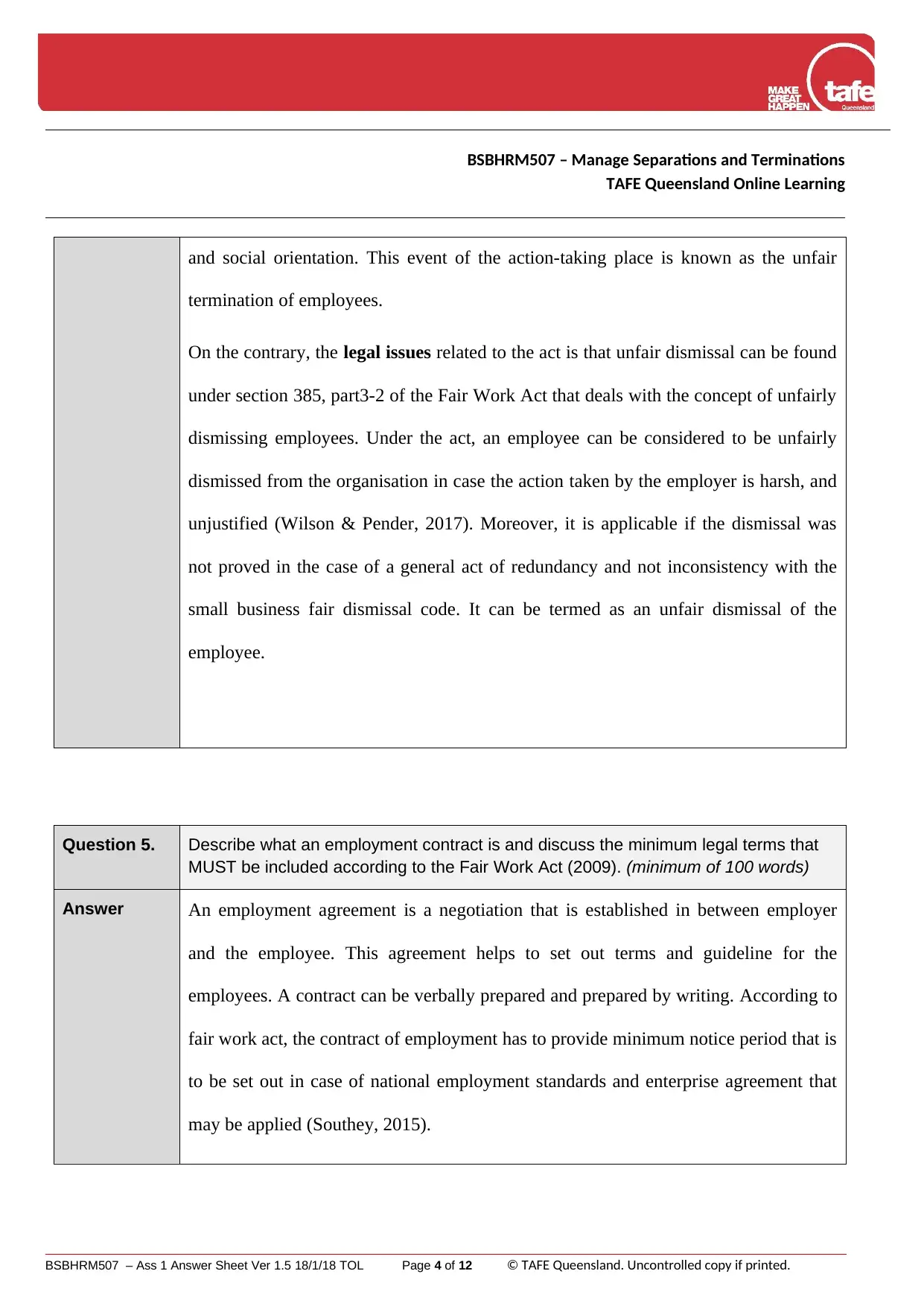
BSBHRM507 Assessment 1 – Answer Sheet
BSBHRM507 – Manage Separations and Terminations
TAFE Queensland Online Learning
and social orientation. This event of the action-taking place is known as the unfair
termination of employees.
On the contrary, the legal issues related to the act is that unfair dismissal can be found
under section 385, part3-2 of the Fair Work Act that deals with the concept of unfairly
dismissing employees. Under the act, an employee can be considered to be unfairly
dismissed from the organisation in case the action taken by the employer is harsh, and
unjustified (Wilson & Pender, 2017). Moreover, it is applicable if the dismissal was
not proved in the case of a general act of redundancy and not inconsistency with the
small business fair dismissal code. It can be termed as an unfair dismissal of the
employee.
Question 5. Describe what an employment contract is and discuss the minimum legal terms that
MUST be included according to the Fair Work Act (2009). (minimum of 100 words)
Answer An employment agreement is a negotiation that is established in between employer
and the employee. This agreement helps to set out terms and guideline for the
employees. A contract can be verbally prepared and prepared by writing. According to
fair work act, the contract of employment has to provide minimum notice period that is
to be set out in case of national employment standards and enterprise agreement that
may be applied (Southey, 2015).
BSBHRM507 – Ass 1 Answer Sheet Ver 1.5 18/1/18 TOL Page 4 of 12 © TAFE Queensland. Uncontrolled copy if printed.
BSBHRM507 – Manage Separations and Terminations
TAFE Queensland Online Learning
and social orientation. This event of the action-taking place is known as the unfair
termination of employees.
On the contrary, the legal issues related to the act is that unfair dismissal can be found
under section 385, part3-2 of the Fair Work Act that deals with the concept of unfairly
dismissing employees. Under the act, an employee can be considered to be unfairly
dismissed from the organisation in case the action taken by the employer is harsh, and
unjustified (Wilson & Pender, 2017). Moreover, it is applicable if the dismissal was
not proved in the case of a general act of redundancy and not inconsistency with the
small business fair dismissal code. It can be termed as an unfair dismissal of the
employee.
Question 5. Describe what an employment contract is and discuss the minimum legal terms that
MUST be included according to the Fair Work Act (2009). (minimum of 100 words)
Answer An employment agreement is a negotiation that is established in between employer
and the employee. This agreement helps to set out terms and guideline for the
employees. A contract can be verbally prepared and prepared by writing. According to
fair work act, the contract of employment has to provide minimum notice period that is
to be set out in case of national employment standards and enterprise agreement that
may be applied (Southey, 2015).
BSBHRM507 – Ass 1 Answer Sheet Ver 1.5 18/1/18 TOL Page 4 of 12 © TAFE Queensland. Uncontrolled copy if printed.
Secure Best Marks with AI Grader
Need help grading? Try our AI Grader for instant feedback on your assignments.
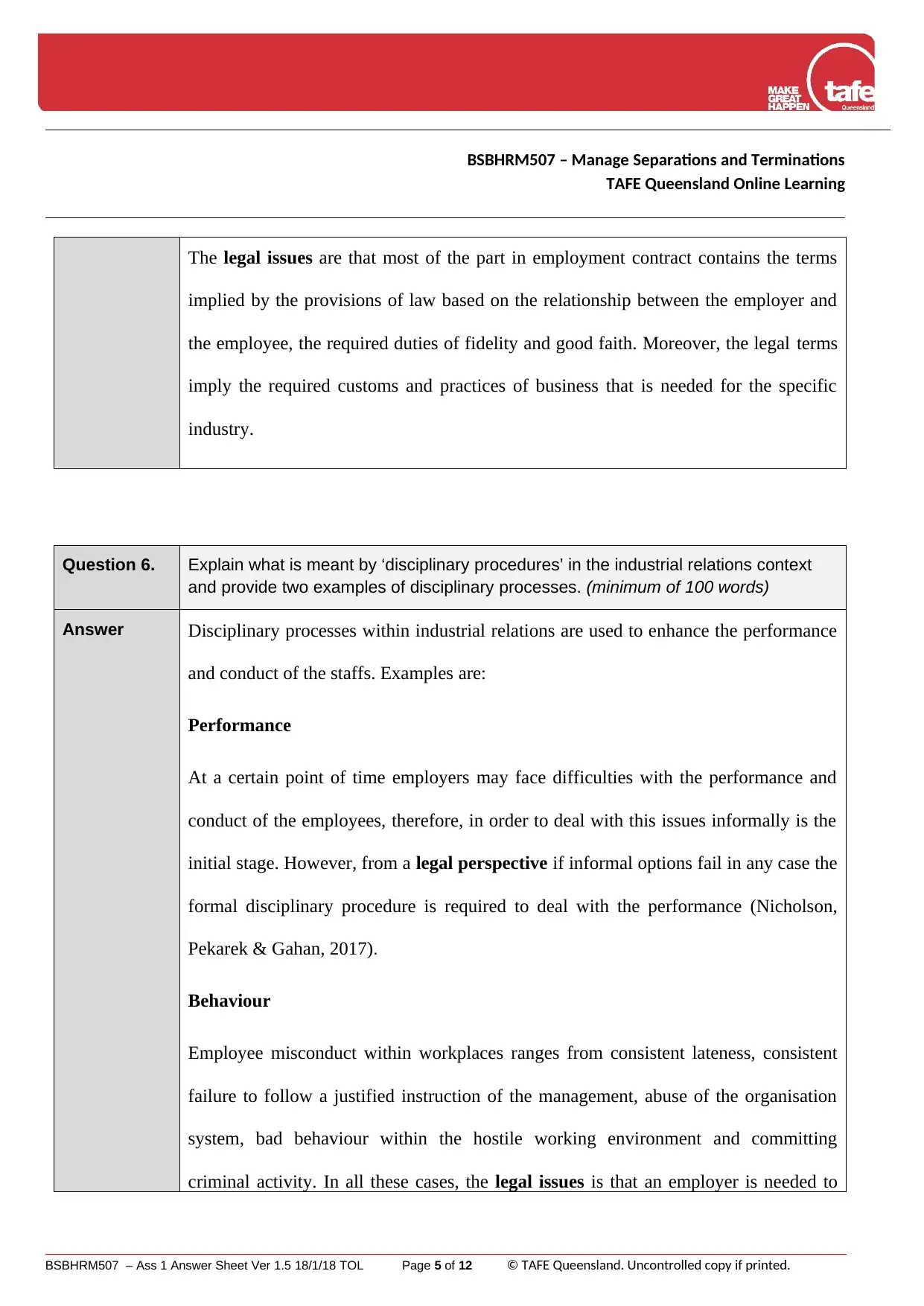
BSBHRM507 Assessment 1 – Answer Sheet
BSBHRM507 – Manage Separations and Terminations
TAFE Queensland Online Learning
The legal issues are that most of the part in employment contract contains the terms
implied by the provisions of law based on the relationship between the employer and
the employee, the required duties of fidelity and good faith. Moreover, the legal terms
imply the required customs and practices of business that is needed for the specific
industry.
Question 6. Explain what is meant by ‘disciplinary procedures’ in the industrial relations context
and provide two examples of disciplinary processes. (minimum of 100 words)
Answer Disciplinary processes within industrial relations are used to enhance the performance
and conduct of the staffs. Examples are:
Performance
At a certain point of time employers may face difficulties with the performance and
conduct of the employees, therefore, in order to deal with this issues informally is the
initial stage. However, from a legal perspective if informal options fail in any case the
formal disciplinary procedure is required to deal with the performance (Nicholson,
Pekarek & Gahan, 2017).
Behaviour
Employee misconduct within workplaces ranges from consistent lateness, consistent
failure to follow a justified instruction of the management, abuse of the organisation
system, bad behaviour within the hostile working environment and committing
criminal activity. In all these cases, the legal issues is that an employer is needed to
BSBHRM507 – Ass 1 Answer Sheet Ver 1.5 18/1/18 TOL Page 5 of 12 © TAFE Queensland. Uncontrolled copy if printed.
BSBHRM507 – Manage Separations and Terminations
TAFE Queensland Online Learning
The legal issues are that most of the part in employment contract contains the terms
implied by the provisions of law based on the relationship between the employer and
the employee, the required duties of fidelity and good faith. Moreover, the legal terms
imply the required customs and practices of business that is needed for the specific
industry.
Question 6. Explain what is meant by ‘disciplinary procedures’ in the industrial relations context
and provide two examples of disciplinary processes. (minimum of 100 words)
Answer Disciplinary processes within industrial relations are used to enhance the performance
and conduct of the staffs. Examples are:
Performance
At a certain point of time employers may face difficulties with the performance and
conduct of the employees, therefore, in order to deal with this issues informally is the
initial stage. However, from a legal perspective if informal options fail in any case the
formal disciplinary procedure is required to deal with the performance (Nicholson,
Pekarek & Gahan, 2017).
Behaviour
Employee misconduct within workplaces ranges from consistent lateness, consistent
failure to follow a justified instruction of the management, abuse of the organisation
system, bad behaviour within the hostile working environment and committing
criminal activity. In all these cases, the legal issues is that an employer is needed to
BSBHRM507 – Ass 1 Answer Sheet Ver 1.5 18/1/18 TOL Page 5 of 12 © TAFE Queensland. Uncontrolled copy if printed.
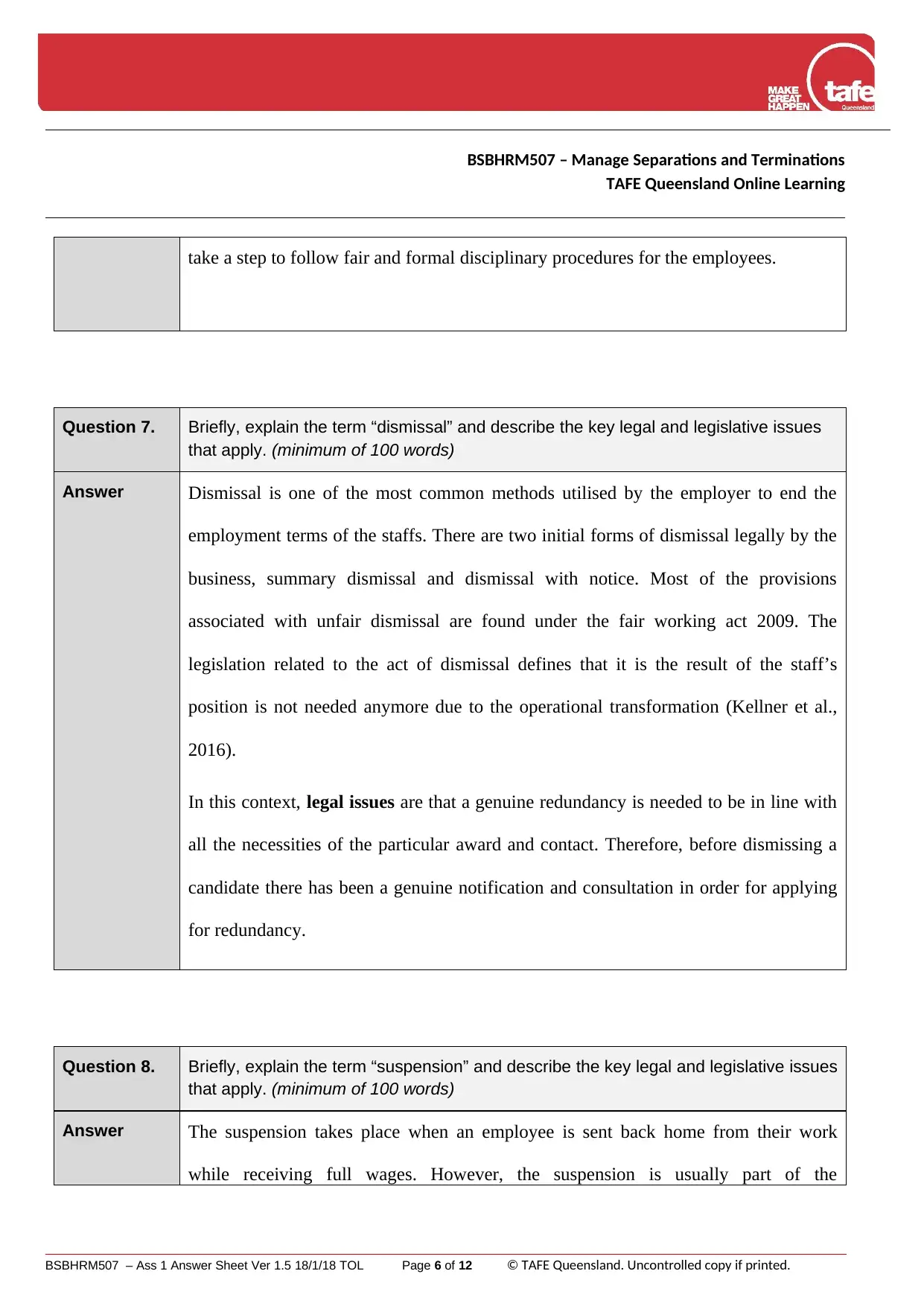
BSBHRM507 Assessment 1 – Answer Sheet
BSBHRM507 – Manage Separations and Terminations
TAFE Queensland Online Learning
take a step to follow fair and formal disciplinary procedures for the employees.
Question 7. Briefly, explain the term “dismissal” and describe the key legal and legislative issues
that apply. (minimum of 100 words)
Answer Dismissal is one of the most common methods utilised by the employer to end the
employment terms of the staffs. There are two initial forms of dismissal legally by the
business, summary dismissal and dismissal with notice. Most of the provisions
associated with unfair dismissal are found under the fair working act 2009. The
legislation related to the act of dismissal defines that it is the result of the staff’s
position is not needed anymore due to the operational transformation (Kellner et al.,
2016).
In this context, legal issues are that a genuine redundancy is needed to be in line with
all the necessities of the particular award and contact. Therefore, before dismissing a
candidate there has been a genuine notification and consultation in order for applying
for redundancy.
Question 8. Briefly, explain the term “suspension” and describe the key legal and legislative issues
that apply. (minimum of 100 words)
Answer The suspension takes place when an employee is sent back home from their work
while receiving full wages. However, the suspension is usually part of the
BSBHRM507 – Ass 1 Answer Sheet Ver 1.5 18/1/18 TOL Page 6 of 12 © TAFE Queensland. Uncontrolled copy if printed.
BSBHRM507 – Manage Separations and Terminations
TAFE Queensland Online Learning
take a step to follow fair and formal disciplinary procedures for the employees.
Question 7. Briefly, explain the term “dismissal” and describe the key legal and legislative issues
that apply. (minimum of 100 words)
Answer Dismissal is one of the most common methods utilised by the employer to end the
employment terms of the staffs. There are two initial forms of dismissal legally by the
business, summary dismissal and dismissal with notice. Most of the provisions
associated with unfair dismissal are found under the fair working act 2009. The
legislation related to the act of dismissal defines that it is the result of the staff’s
position is not needed anymore due to the operational transformation (Kellner et al.,
2016).
In this context, legal issues are that a genuine redundancy is needed to be in line with
all the necessities of the particular award and contact. Therefore, before dismissing a
candidate there has been a genuine notification and consultation in order for applying
for redundancy.
Question 8. Briefly, explain the term “suspension” and describe the key legal and legislative issues
that apply. (minimum of 100 words)
Answer The suspension takes place when an employee is sent back home from their work
while receiving full wages. However, the suspension is usually part of the
BSBHRM507 – Ass 1 Answer Sheet Ver 1.5 18/1/18 TOL Page 6 of 12 © TAFE Queensland. Uncontrolled copy if printed.
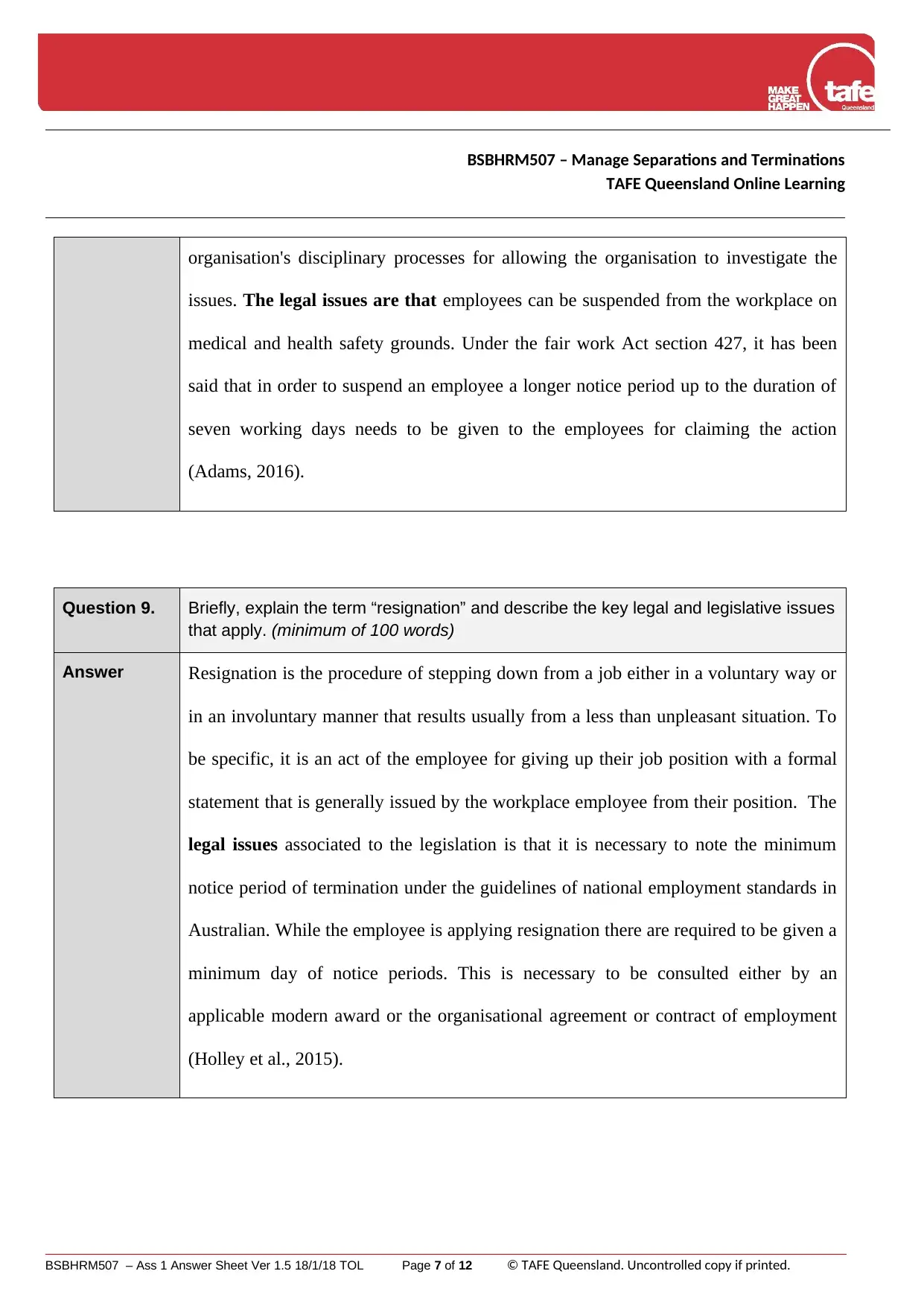
BSBHRM507 Assessment 1 – Answer Sheet
BSBHRM507 – Manage Separations and Terminations
TAFE Queensland Online Learning
organisation's disciplinary processes for allowing the organisation to investigate the
issues. The legal issues are that employees can be suspended from the workplace on
medical and health safety grounds. Under the fair work Act section 427, it has been
said that in order to suspend an employee a longer notice period up to the duration of
seven working days needs to be given to the employees for claiming the action
(Adams, 2016).
Question 9. Briefly, explain the term “resignation” and describe the key legal and legislative issues
that apply. (minimum of 100 words)
Answer Resignation is the procedure of stepping down from a job either in a voluntary way or
in an involuntary manner that results usually from a less than unpleasant situation. To
be specific, it is an act of the employee for giving up their job position with a formal
statement that is generally issued by the workplace employee from their position. The
legal issues associated to the legislation is that it is necessary to note the minimum
notice period of termination under the guidelines of national employment standards in
Australian. While the employee is applying resignation there are required to be given a
minimum day of notice periods. This is necessary to be consulted either by an
applicable modern award or the organisational agreement or contract of employment
(Holley et al., 2015).
BSBHRM507 – Ass 1 Answer Sheet Ver 1.5 18/1/18 TOL Page 7 of 12 © TAFE Queensland. Uncontrolled copy if printed.
BSBHRM507 – Manage Separations and Terminations
TAFE Queensland Online Learning
organisation's disciplinary processes for allowing the organisation to investigate the
issues. The legal issues are that employees can be suspended from the workplace on
medical and health safety grounds. Under the fair work Act section 427, it has been
said that in order to suspend an employee a longer notice period up to the duration of
seven working days needs to be given to the employees for claiming the action
(Adams, 2016).
Question 9. Briefly, explain the term “resignation” and describe the key legal and legislative issues
that apply. (minimum of 100 words)
Answer Resignation is the procedure of stepping down from a job either in a voluntary way or
in an involuntary manner that results usually from a less than unpleasant situation. To
be specific, it is an act of the employee for giving up their job position with a formal
statement that is generally issued by the workplace employee from their position. The
legal issues associated to the legislation is that it is necessary to note the minimum
notice period of termination under the guidelines of national employment standards in
Australian. While the employee is applying resignation there are required to be given a
minimum day of notice periods. This is necessary to be consulted either by an
applicable modern award or the organisational agreement or contract of employment
(Holley et al., 2015).
BSBHRM507 – Ass 1 Answer Sheet Ver 1.5 18/1/18 TOL Page 7 of 12 © TAFE Queensland. Uncontrolled copy if printed.
Paraphrase This Document
Need a fresh take? Get an instant paraphrase of this document with our AI Paraphraser
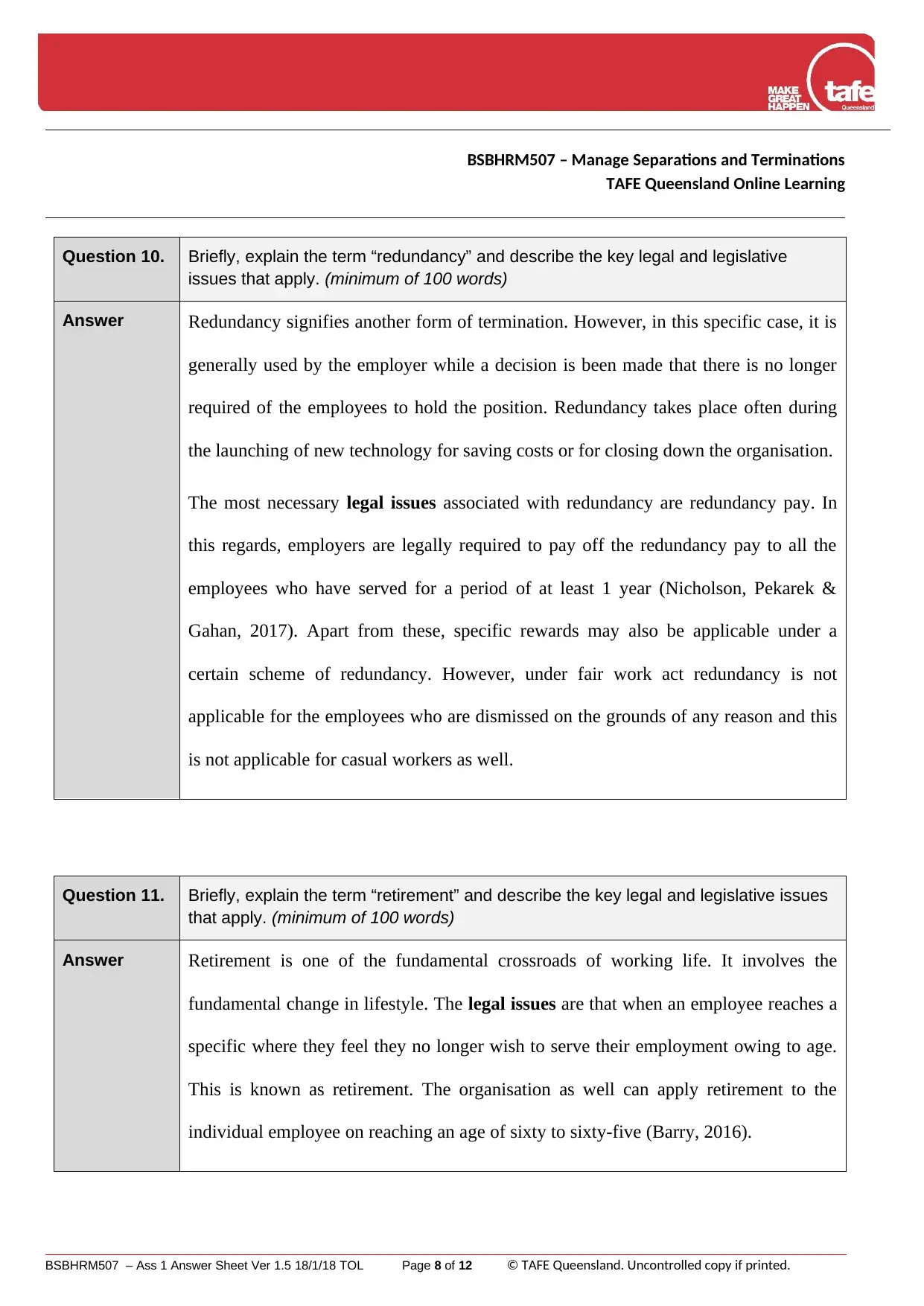
BSBHRM507 Assessment 1 – Answer Sheet
BSBHRM507 – Manage Separations and Terminations
TAFE Queensland Online Learning
Question 10. Briefly, explain the term “redundancy” and describe the key legal and legislative
issues that apply. (minimum of 100 words)
Answer Redundancy signifies another form of termination. However, in this specific case, it is
generally used by the employer while a decision is been made that there is no longer
required of the employees to hold the position. Redundancy takes place often during
the launching of new technology for saving costs or for closing down the organisation.
The most necessary legal issues associated with redundancy are redundancy pay. In
this regards, employers are legally required to pay off the redundancy pay to all the
employees who have served for a period of at least 1 year (Nicholson, Pekarek &
Gahan, 2017). Apart from these, specific rewards may also be applicable under a
certain scheme of redundancy. However, under fair work act redundancy is not
applicable for the employees who are dismissed on the grounds of any reason and this
is not applicable for casual workers as well.
Question 11. Briefly, explain the term “retirement” and describe the key legal and legislative issues
that apply. (minimum of 100 words)
Answer Retirement is one of the fundamental crossroads of working life. It involves the
fundamental change in lifestyle. The legal issues are that when an employee reaches a
specific where they feel they no longer wish to serve their employment owing to age.
This is known as retirement. The organisation as well can apply retirement to the
individual employee on reaching an age of sixty to sixty-five (Barry, 2016).
BSBHRM507 – Ass 1 Answer Sheet Ver 1.5 18/1/18 TOL Page 8 of 12 © TAFE Queensland. Uncontrolled copy if printed.
BSBHRM507 – Manage Separations and Terminations
TAFE Queensland Online Learning
Question 10. Briefly, explain the term “redundancy” and describe the key legal and legislative
issues that apply. (minimum of 100 words)
Answer Redundancy signifies another form of termination. However, in this specific case, it is
generally used by the employer while a decision is been made that there is no longer
required of the employees to hold the position. Redundancy takes place often during
the launching of new technology for saving costs or for closing down the organisation.
The most necessary legal issues associated with redundancy are redundancy pay. In
this regards, employers are legally required to pay off the redundancy pay to all the
employees who have served for a period of at least 1 year (Nicholson, Pekarek &
Gahan, 2017). Apart from these, specific rewards may also be applicable under a
certain scheme of redundancy. However, under fair work act redundancy is not
applicable for the employees who are dismissed on the grounds of any reason and this
is not applicable for casual workers as well.
Question 11. Briefly, explain the term “retirement” and describe the key legal and legislative issues
that apply. (minimum of 100 words)
Answer Retirement is one of the fundamental crossroads of working life. It involves the
fundamental change in lifestyle. The legal issues are that when an employee reaches a
specific where they feel they no longer wish to serve their employment owing to age.
This is known as retirement. The organisation as well can apply retirement to the
individual employee on reaching an age of sixty to sixty-five (Barry, 2016).
BSBHRM507 – Ass 1 Answer Sheet Ver 1.5 18/1/18 TOL Page 8 of 12 © TAFE Queensland. Uncontrolled copy if printed.
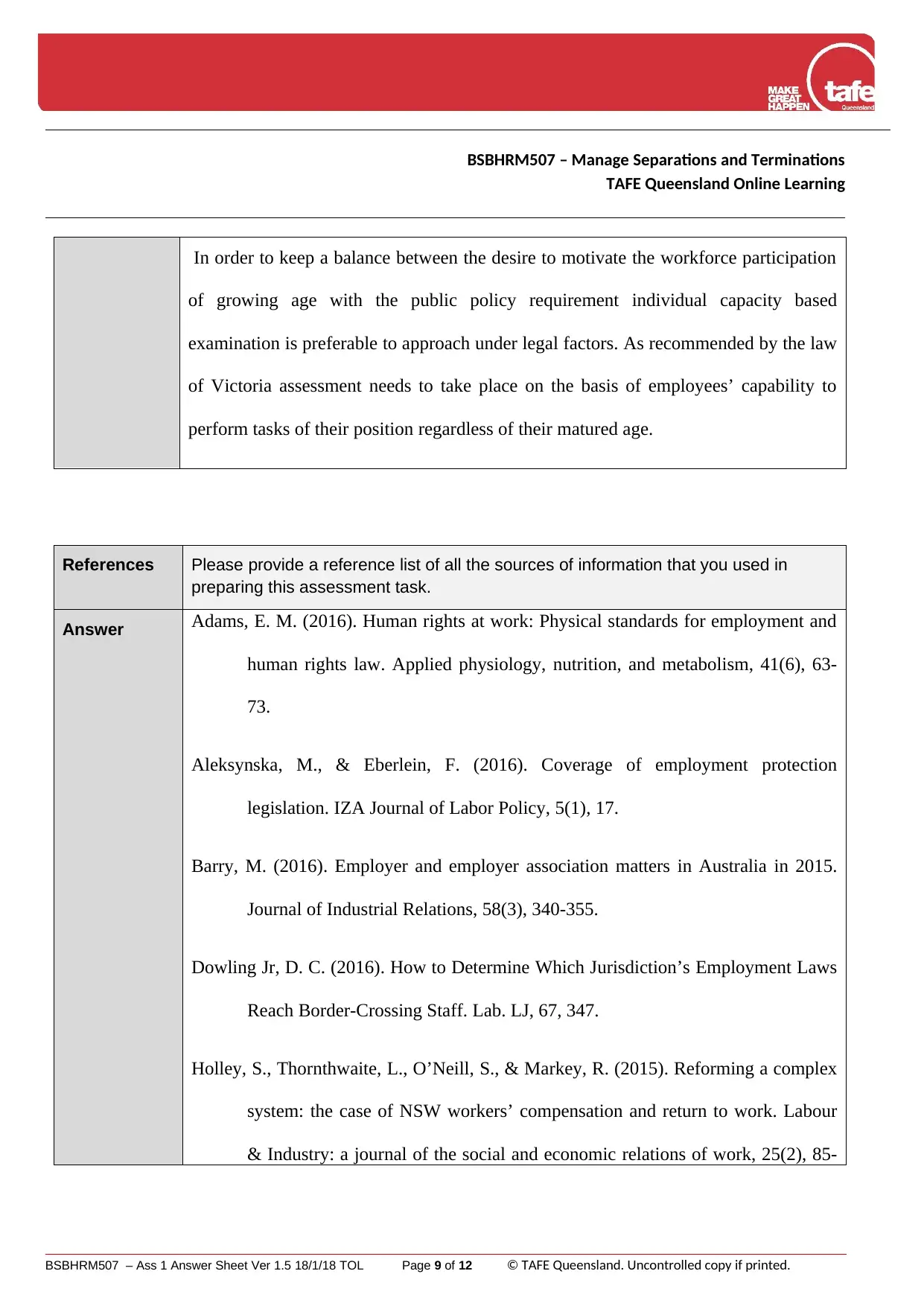
BSBHRM507 Assessment 1 – Answer Sheet
BSBHRM507 – Manage Separations and Terminations
TAFE Queensland Online Learning
In order to keep a balance between the desire to motivate the workforce participation
of growing age with the public policy requirement individual capacity based
examination is preferable to approach under legal factors. As recommended by the law
of Victoria assessment needs to take place on the basis of employees’ capability to
perform tasks of their position regardless of their matured age.
References Please provide a reference list of all the sources of information that you used in
preparing this assessment task.
Answer Adams, E. M. (2016). Human rights at work: Physical standards for employment and
human rights law. Applied physiology, nutrition, and metabolism, 41(6), 63-
73.
Aleksynska, M., & Eberlein, F. (2016). Coverage of employment protection
legislation. IZA Journal of Labor Policy, 5(1), 17.
Barry, M. (2016). Employer and employer association matters in Australia in 2015.
Journal of Industrial Relations, 58(3), 340-355.
Dowling Jr, D. C. (2016). How to Determine Which Jurisdiction’s Employment Laws
Reach Border-Crossing Staff. Lab. LJ, 67, 347.
Holley, S., Thornthwaite, L., O’Neill, S., & Markey, R. (2015). Reforming a complex
system: the case of NSW workers’ compensation and return to work. Labour
& Industry: a journal of the social and economic relations of work, 25(2), 85-
BSBHRM507 – Ass 1 Answer Sheet Ver 1.5 18/1/18 TOL Page 9 of 12 © TAFE Queensland. Uncontrolled copy if printed.
BSBHRM507 – Manage Separations and Terminations
TAFE Queensland Online Learning
In order to keep a balance between the desire to motivate the workforce participation
of growing age with the public policy requirement individual capacity based
examination is preferable to approach under legal factors. As recommended by the law
of Victoria assessment needs to take place on the basis of employees’ capability to
perform tasks of their position regardless of their matured age.
References Please provide a reference list of all the sources of information that you used in
preparing this assessment task.
Answer Adams, E. M. (2016). Human rights at work: Physical standards for employment and
human rights law. Applied physiology, nutrition, and metabolism, 41(6), 63-
73.
Aleksynska, M., & Eberlein, F. (2016). Coverage of employment protection
legislation. IZA Journal of Labor Policy, 5(1), 17.
Barry, M. (2016). Employer and employer association matters in Australia in 2015.
Journal of Industrial Relations, 58(3), 340-355.
Dowling Jr, D. C. (2016). How to Determine Which Jurisdiction’s Employment Laws
Reach Border-Crossing Staff. Lab. LJ, 67, 347.
Holley, S., Thornthwaite, L., O’Neill, S., & Markey, R. (2015). Reforming a complex
system: the case of NSW workers’ compensation and return to work. Labour
& Industry: a journal of the social and economic relations of work, 25(2), 85-
BSBHRM507 – Ass 1 Answer Sheet Ver 1.5 18/1/18 TOL Page 9 of 12 © TAFE Queensland. Uncontrolled copy if printed.
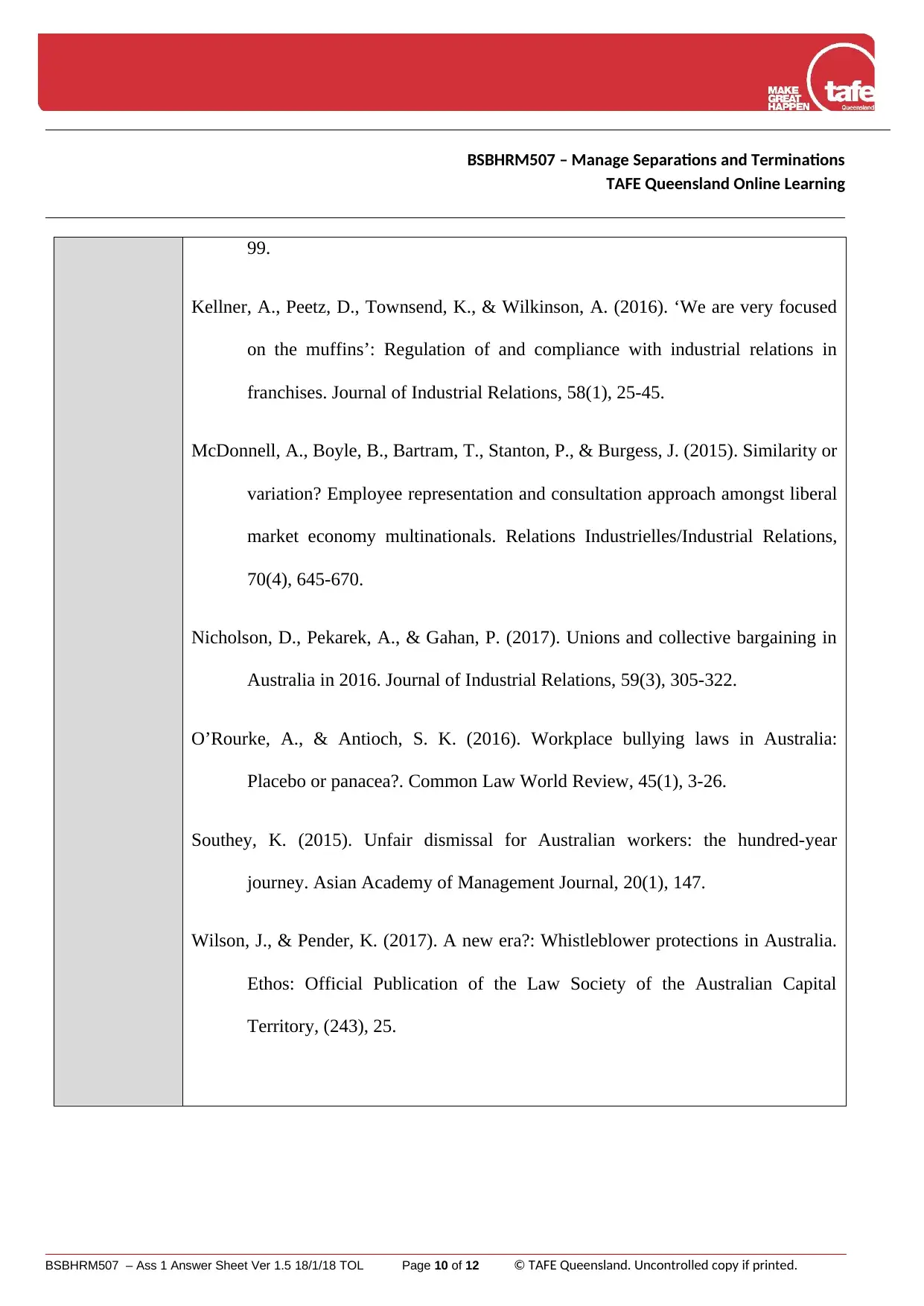
BSBHRM507 Assessment 1 – Answer Sheet
BSBHRM507 – Manage Separations and Terminations
TAFE Queensland Online Learning
99.
Kellner, A., Peetz, D., Townsend, K., & Wilkinson, A. (2016). ‘We are very focused
on the muffins’: Regulation of and compliance with industrial relations in
franchises. Journal of Industrial Relations, 58(1), 25-45.
McDonnell, A., Boyle, B., Bartram, T., Stanton, P., & Burgess, J. (2015). Similarity or
variation? Employee representation and consultation approach amongst liberal
market economy multinationals. Relations Industrielles/Industrial Relations,
70(4), 645-670.
Nicholson, D., Pekarek, A., & Gahan, P. (2017). Unions and collective bargaining in
Australia in 2016. Journal of Industrial Relations, 59(3), 305-322.
O’Rourke, A., & Antioch, S. K. (2016). Workplace bullying laws in Australia:
Placebo or panacea?. Common Law World Review, 45(1), 3-26.
Southey, K. (2015). Unfair dismissal for Australian workers: the hundred-year
journey. Asian Academy of Management Journal, 20(1), 147.
Wilson, J., & Pender, K. (2017). A new era?: Whistleblower protections in Australia.
Ethos: Official Publication of the Law Society of the Australian Capital
Territory, (243), 25.
BSBHRM507 – Ass 1 Answer Sheet Ver 1.5 18/1/18 TOL Page 10 of 12 © TAFE Queensland. Uncontrolled copy if printed.
BSBHRM507 – Manage Separations and Terminations
TAFE Queensland Online Learning
99.
Kellner, A., Peetz, D., Townsend, K., & Wilkinson, A. (2016). ‘We are very focused
on the muffins’: Regulation of and compliance with industrial relations in
franchises. Journal of Industrial Relations, 58(1), 25-45.
McDonnell, A., Boyle, B., Bartram, T., Stanton, P., & Burgess, J. (2015). Similarity or
variation? Employee representation and consultation approach amongst liberal
market economy multinationals. Relations Industrielles/Industrial Relations,
70(4), 645-670.
Nicholson, D., Pekarek, A., & Gahan, P. (2017). Unions and collective bargaining in
Australia in 2016. Journal of Industrial Relations, 59(3), 305-322.
O’Rourke, A., & Antioch, S. K. (2016). Workplace bullying laws in Australia:
Placebo or panacea?. Common Law World Review, 45(1), 3-26.
Southey, K. (2015). Unfair dismissal for Australian workers: the hundred-year
journey. Asian Academy of Management Journal, 20(1), 147.
Wilson, J., & Pender, K. (2017). A new era?: Whistleblower protections in Australia.
Ethos: Official Publication of the Law Society of the Australian Capital
Territory, (243), 25.
BSBHRM507 – Ass 1 Answer Sheet Ver 1.5 18/1/18 TOL Page 10 of 12 © TAFE Queensland. Uncontrolled copy if printed.
Secure Best Marks with AI Grader
Need help grading? Try our AI Grader for instant feedback on your assignments.
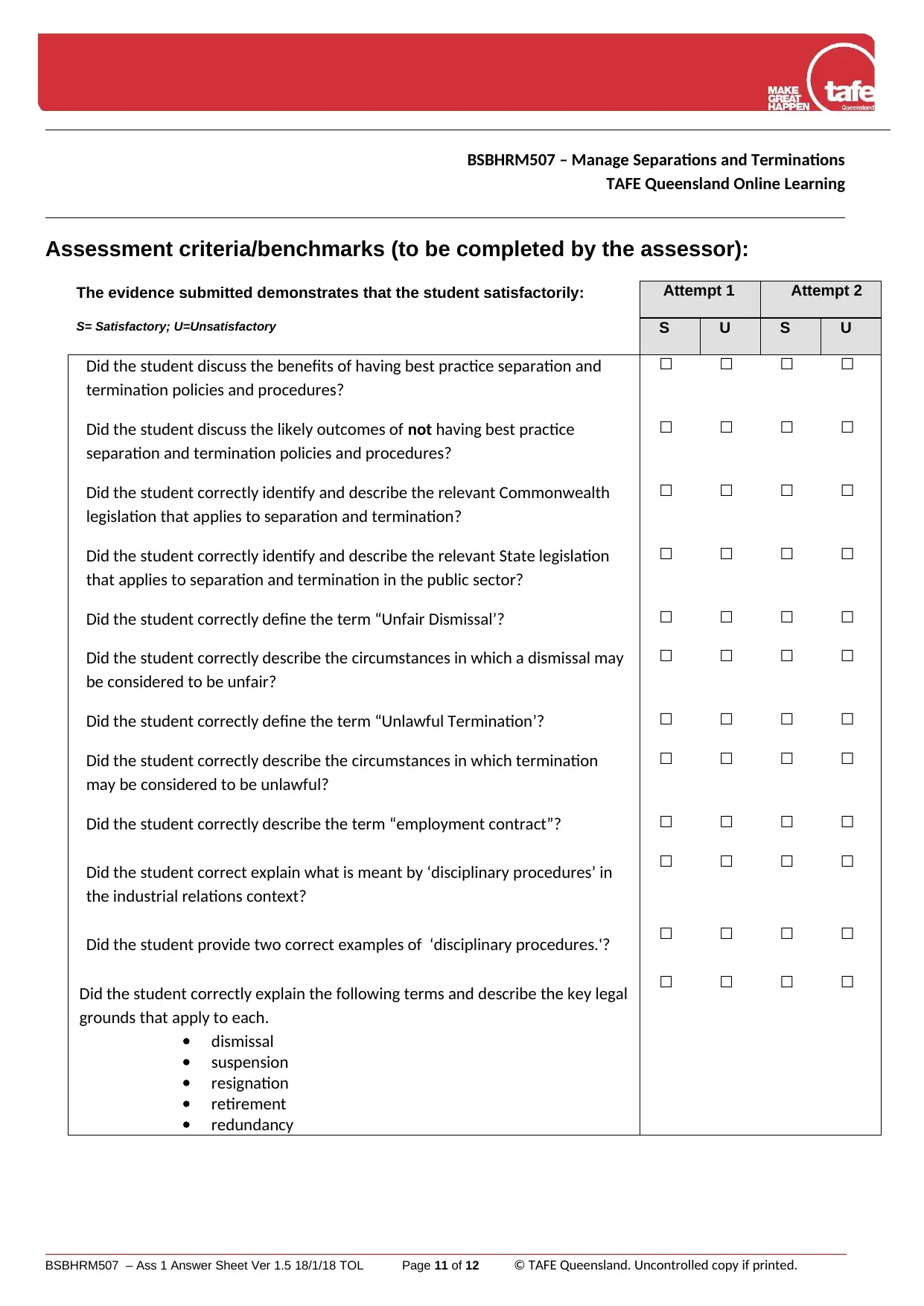
BSBHRM507 Assessment 1 – Answer Sheet
BSBHRM507 – Manage Separations and Terminations
TAFE Queensland Online Learning
Assessment criteria/benchmarks (to be completed by the assessor):
The evidence submitted demonstrates that the student satisfactorily:
S= Satisfactory; U=Unsatisfactory
Attempt 1 Attempt 2
S U S U
Did the student discuss the benefits of having best practice separation and
termination policies and procedures?
☐ ☐ ☐ ☐
Did the student discuss the likely outcomes of not having best practice
separation and termination policies and procedures?
☐ ☐ ☐ ☐
Did the student correctly identify and describe the relevant Commonwealth
legislation that applies to separation and termination?
☐ ☐ ☐ ☐
Did the student correctly identify and describe the relevant State legislation
that applies to separation and termination in the public sector?
☐ ☐ ☐ ☐
Did the student correctly define the term “Unfair Dismissal’? ☐ ☐ ☐ ☐
Did the student correctly describe the circumstances in which a dismissal may
be considered to be unfair?
☐ ☐ ☐ ☐
Did the student correctly define the term “Unlawful Termination’? ☐ ☐ ☐ ☐
Did the student correctly describe the circumstances in which termination
may be considered to be unlawful?
☐ ☐ ☐ ☐
Did the student correctly describe the term “employment contract”? ☐ ☐ ☐ ☐
Did the student correct explain what is meant by ‘disciplinary procedures’ in
the industrial relations context?
☐ ☐ ☐ ☐
Did the student provide two correct examples of ‘disciplinary procedures.'? ☐ ☐ ☐ ☐
Did the student correctly explain the following terms and describe the key legal
grounds that apply to each.
dismissal
suspension
resignation
retirement
redundancy
☐ ☐ ☐ ☐
BSBHRM507 – Ass 1 Answer Sheet Ver 1.5 18/1/18 TOL Page 11 of 12 © TAFE Queensland. Uncontrolled copy if printed.
BSBHRM507 – Manage Separations and Terminations
TAFE Queensland Online Learning
Assessment criteria/benchmarks (to be completed by the assessor):
The evidence submitted demonstrates that the student satisfactorily:
S= Satisfactory; U=Unsatisfactory
Attempt 1 Attempt 2
S U S U
Did the student discuss the benefits of having best practice separation and
termination policies and procedures?
☐ ☐ ☐ ☐
Did the student discuss the likely outcomes of not having best practice
separation and termination policies and procedures?
☐ ☐ ☐ ☐
Did the student correctly identify and describe the relevant Commonwealth
legislation that applies to separation and termination?
☐ ☐ ☐ ☐
Did the student correctly identify and describe the relevant State legislation
that applies to separation and termination in the public sector?
☐ ☐ ☐ ☐
Did the student correctly define the term “Unfair Dismissal’? ☐ ☐ ☐ ☐
Did the student correctly describe the circumstances in which a dismissal may
be considered to be unfair?
☐ ☐ ☐ ☐
Did the student correctly define the term “Unlawful Termination’? ☐ ☐ ☐ ☐
Did the student correctly describe the circumstances in which termination
may be considered to be unlawful?
☐ ☐ ☐ ☐
Did the student correctly describe the term “employment contract”? ☐ ☐ ☐ ☐
Did the student correct explain what is meant by ‘disciplinary procedures’ in
the industrial relations context?
☐ ☐ ☐ ☐
Did the student provide two correct examples of ‘disciplinary procedures.'? ☐ ☐ ☐ ☐
Did the student correctly explain the following terms and describe the key legal
grounds that apply to each.
dismissal
suspension
resignation
retirement
redundancy
☐ ☐ ☐ ☐
BSBHRM507 – Ass 1 Answer Sheet Ver 1.5 18/1/18 TOL Page 11 of 12 © TAFE Queensland. Uncontrolled copy if printed.

BSBHRM507 Assessment 1 – Answer Sheet
BSBHRM507 – Manage Separations and Terminations
TAFE Queensland Online Learning
Assessor Name Date Assessed
Assessor Comments
and Feedback
Result Attempt 1 ☐ Satisfactory ☐ Resubmit ☐ Unsatisfactory
Result Attempt 2 ☐ Not Applicable ☐ Satisfactory ☐ Unsatisfactory
BSBHRM507 – Ass 1 Answer Sheet Ver 1.5 18/1/18 TOL Page 12 of 12 © TAFE Queensland. Uncontrolled copy if printed.
BSBHRM507 – Manage Separations and Terminations
TAFE Queensland Online Learning
Assessor Name Date Assessed
Assessor Comments
and Feedback
Result Attempt 1 ☐ Satisfactory ☐ Resubmit ☐ Unsatisfactory
Result Attempt 2 ☐ Not Applicable ☐ Satisfactory ☐ Unsatisfactory
BSBHRM507 – Ass 1 Answer Sheet Ver 1.5 18/1/18 TOL Page 12 of 12 © TAFE Queensland. Uncontrolled copy if printed.
1 out of 12
Related Documents
Your All-in-One AI-Powered Toolkit for Academic Success.
+13062052269
info@desklib.com
Available 24*7 on WhatsApp / Email
![[object Object]](/_next/static/media/star-bottom.7253800d.svg)
Unlock your academic potential
© 2024 | Zucol Services PVT LTD | All rights reserved.




